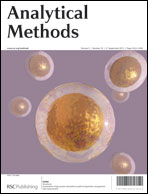A comparative study on the analytical performance of a charged aerosol detector and an ultraviolet detector for the RP-LC analysis of dabigatran etexilate in capsules
Abstract
The reversed-phase liquid chromatography (RP-LC) method was validated for the assessment of dabigatran etexilate (DAB) in capsules using an ultraviolet detector (UV) and a charged aerosol detector (CAD) connected in series. The RP-LC method was carried out on a GL Sciences Inc. Inertsil ODS-2 column (250 mm × 4.6 mm I.D.). The mobile phase consisted of acetonitrile and ammonium acetate buffer (pH 5.5; 10 mM) (65 : 35, v/v) (flow rate 1.0 mL min−1). CAD detection was performed using a nitrogen pressure of 35 psi and a range of 100 pA and the UV detection at 225 nm. The chromatographic separation was obtained with a retention time of 6.7 min. Validation parameters such as specificity, linearity, precision, accuracy and robustness were evaluated. The method was linear over the concentration range of 1–70 μg mL−1 in both detectors. The specificity and stability-indicating capability of the method were proven through the degradation studies, which also show that there was no interference from the excipients. The method was precise and accurate, with the Plackett–Burman experimental design used to evaluate robustness, delivering results within the acceptable range. The method was successfully applied for DAB analysis and the results of the CAD and UV detectors were compared, showing a non-significant difference (P > 0.05).


 Please wait while we load your content...
Please wait while we load your content...